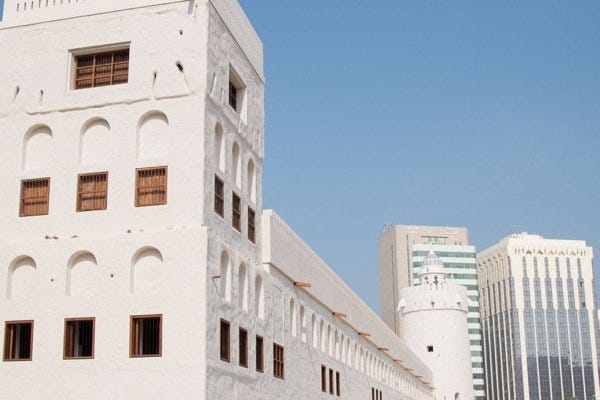The oldest building in Abu Dhabi - Qasr Al Hosn
It's no secret that I love this place, having attended one of the few short festivals that took place on the grounds a few years ago, I swiftly fell in love with Qasr Al Hosn. I remember having a short guided tour around the inside courtyards of the Fort and I was captivated. I wanted to see more, except for ten long years it hasn't been possible to see any more than I did that day due to the extensive restoration process the building was undergoing. But now, back in early Dec 2018, the oldest building in the city and the structure with the most significant role in the founding of Abu Dhabi and the UAE, finally reopened in all its glory to the public.
So what exactly is Qasr Al Hosn?
Qasr Al Hosn started out life as a simple watch tower and dates back to the 1790s. It was the first permanent structure in Abu Dhabi and has an important history of first protecting the settlements on the island, then as the home of the ruling family and even the first seat of government in the country.
Although the fort is perhaps the most well known, the site at Qasr Al Hosn is actually made up of several separate parts:
Cultural Foundation
Opened in 1981, the Cultural Foundation was established with the goal of providing a place committed to developing heritage and arts in the capital.
Today, the Cultural Foundation is home to art exhibitions, performances and arts and heritage workshops. As well as exhibition spaces there is also a theatre and a pretty spectacular looking Children's Library is due to open sometime during 2019.
The House of Artisans
The House of Artisans is housed within the modern permanent structure on the site that previously housed the Qasr Al Hosn exhibition. Inside is an exhibition dedicated to the traditional crafts of the UAE where you can learn about Sadu and Khoos weaving, Talli embroidery and traditional sea crafts of the country as well as catch live demonstrations of the crafts too.
The National Consultative Council
The National Consultative Council building was constructed as the place for the unification talks of the Trucial States to take place. The building played host to numerous Federal and national meetings and basically is the birthplace of the modern governmental system we now know in the capital.
Qasr Al Hosn - The fort and palace
Built by the Bani Yas tribes as a humble watchtower to protect the growing settlement, by the 1790s the tower was complete and Qasr Al Hosn was born.
Between 1790 and the 1850s the tower was expanded upon to become a fortress and the seat of power moved from Liwa to here by Sheikh Shakhbut where he used the fort as his home, military headquarters and the seat of government.
Later, in 1939 Sheikh Shakhbut Bin Sultan Al Nahyan began negotiating oil exploration with the British from the site, and construction began for the palace that now sits around the outside of the early fort.
The site is without a doubt the most significant building in the capital in terms of the history of the Emirate and country, although it always surprises me how few people seem to know much about it or have visited it.
There's plenty going on at the site, check the website for daily activities and shows taking place, there's regular heritage dances and demonstrations to see.
After entering through the main gate, the path leads you directly into the old fort where a museum now lies, detailing the history of the site and the part it played in the formation of the country, as well as illustrating the traditions of society and what daily life involved in those early days.
Further on, through the courtyards you can enter the palace to gain an insight into how life in the desert was - and not all that long ago - by visiting the rooms the royal family used to call home.
Each room houses different surprises with information to read and some with activities to complete, including one room where you can get your Trucial States passport stamped. There's also a dress-up room and a room with giant blocks to build your own version of the fort, all activities that are great for keeping the kids amused.
If you haven't been, it is absolutely worth visiting. It's a beautiful old structure and the restoration process has been carried out beautifully to revive this icon of the country.
Furthermore, it's also only the Fort and Palace itself and the National Consultative Council building that you need a ticket for. To visit the Cultural Foundation, House of Artisans and the surrounding landscaped areas is completely free.
Find out more online at QasrAlHosn.ae.
















